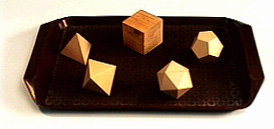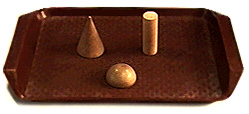
Geometric Solids
Go to Plato's Five Regular
Polyhedra
and Archimedean Polyhedra
MATERIAL:
The Platonian regular solids (tetrahedron, hexahedron,
octahedron, dodecahedron, icosahedron)
Semi-regular solids (prisms - triangular, hexagonal, octagonal
pyramids - hexagonal, etc).
Regular curved solids (sphere, ellipsoid, ovoid)
Solids with curved faces and plane faces (cylinder, cone,
hemisphere)
PURPOSE:
- 1) A study of the classification of geometric solids as a
foundation
- for the later study of geometry.
-
- 2) To learn the words which will be needed and which will allow
the
- child to express him or herself.
-
- 3) To make the child aware of solid forms in the environment and
to
- get the child to observe the environment with intelligence.
PRESENTATION:
- Place the five Platonian solids in the classroom together for the
- children to handle. The children must be able to hold the solids
- in their hands.
-
- Later, after the children have handled the solids and are
familiar
- with them, introduce the terminology associated with the
Platonian
- solids.
-
- Polyhedron and polyhedra (plural) means many faces.
-
- Apex (plural: apices or apexes) - the vertex of an angle. A
- solid is regular if the apices are the same.
-
- Polyhedra have a face, edge, and apex. The Platonian solids were
- first described by Plato.
-

-
There are
nine regular solids: the five Platonian, pictured above, and the
four polyhedra described by Kepler-Poinsot. Each face, apex and angle
on each respective solid is the same.
Platonian solids:
- 1. Tetrahedron - 4 faces, each face an equilateral triangle
- 2. Hexahedron - 6 faces, each face is a square
- 3. Octahedron - 8 faces, each face is an equilateral triangle
- 4. Dodecahedron - 12 faces, each face is a pentagon (5 edges)
- 5. Icosahedron - 20 faces, each face is an equilateral triangle
-
- Kepler-Poinsot solids: four star shaped regular polyhedra;
three were
- described by Kepler and one by Poinsot. The teacher should at
least present a picture of these 4 solids to the children.
-
Semi-regular polyhedra:
These have faces of more than one shape. Thirteen
semi-regular polyhedra were described by Archimedes. Present at least a
picture of them so the children can see them.
Solids Bounded by Straight
Lines:
- Prisms:
- The end face can be any regular polygon.
- The sides are always rectangles.
- Prisms are named by their end faces. For example, the triangular
prism has triangles
- as end faces, and the hexagonal prism has hexagons as the end
faces.
-
- Pyramids:
- These have any regular polygon for a base and isosceles
triangles with a common vertex as the sides.
- A pyramid is named by its base (hexagonal pyramid, etc.).
Regular Curved Solids:
- Sphere: all points on the surface are equidistant from the center
- Ellipsoid: a form whose plane surfaces are either ellipses or
circles
- Ovoid: egg shaped
- Torus: a rounded form on a circular base in the case of a circle,
resembling a doughnut
-
- When the children handle these, let them also roll them and watch
- the path each takes.
Curved solids with plane and
curved surfaces

- Cylinder: a solid bounded by two parallel planes which are curved
- Cone: a solid with a circular base joined by straight lines to
the vertex
- Hemisphere: half a sphere
Plato's Five Regular
Polyhedra
|

TETRAHEDRON
|

HEXAHEDRON
|

OCTAHEDRON
|
|

DODECAHEDRON
|

ICOSAHEDRON
|
Archimedian Polyhedra
|

TRUNCATED TETRAHEDRON
|

TRUNCATED CUBE
|

TRUNCATED OCTAHEDRON
|
|

SNUB CUBE
|

TRUNCATED OCTAHEDRON
|

TRUNCATED ICOSAHEDRON
|
|

SMALL RHOMBICUBOCHEDRON
|

GREAT RHOMBECUBOCTAHEDRON
|

CUBOCTAHEDRON
|
|

ICOSIDODECAHEDRON
|

SNUB DODECAHEDRON
|

SMALL RHOMBICOSIDODECAHEDRON
|
-
Home Page | Readings and Reference
-
Table of Contents

